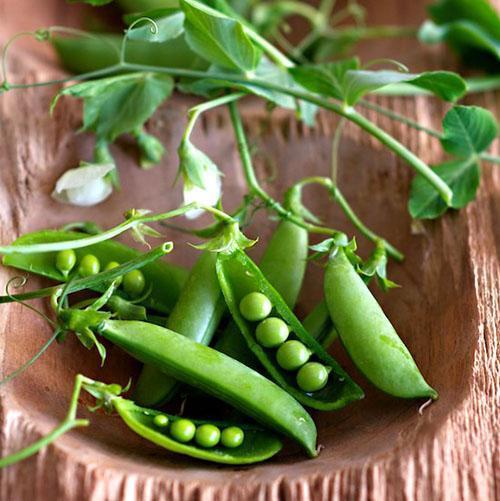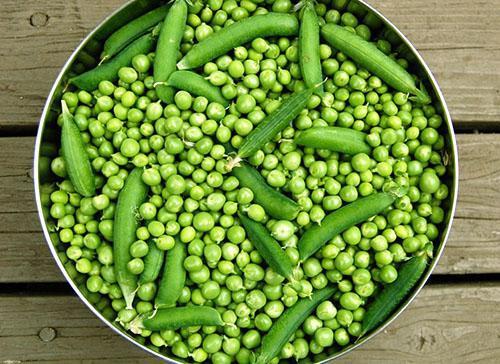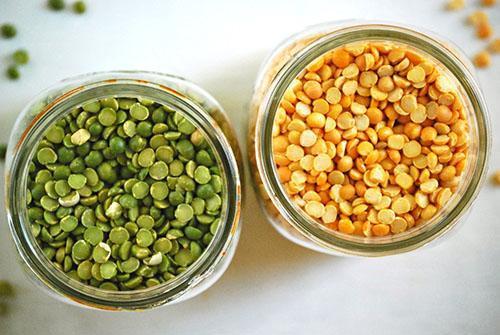Popular tips: how to prepare peas for the winter
 Peas are one of the most demanded and widespread leguminous plants not only in our country, but all over the world. This is facilitated by the unpretentiousness, early maturity and yield of the crop, as well as the high nutritional value of the harvested beans. Back in the Bronze Age, people knew how to collect and dry the fruits of wild legumes.
Peas are one of the most demanded and widespread leguminous plants not only in our country, but all over the world. This is facilitated by the unpretentiousness, early maturity and yield of the crop, as well as the high nutritional value of the harvested beans. Back in the Bronze Age, people knew how to collect and dry the fruits of wild legumes.
Today peas are recognized as a storehouse of protein, fiber, sugars and vitamins. Ripe peas contain up to 35.7% protein, while the fruits are one and a half times more caloric than potatoes... It is not for nothing that green peas are called sweet, since at the time of technical maturity about 4.8-7% of sugar accumulates in it, quite a lot of ascorbic acid, vitamin PP, carotene and B vitamins. In addition, juicy peas contain sodium and potassium, phosphorus , iron and calcium, essential amino acids, proteins and fiber.
Peas grown by agricultural enterprises under current conditions are not only dried, but also frozen, canned, flour and other types of products are obtained from it.

Ripe peas, as they lose moisture and dry out, acquire a wrinkled surface, but there are also varieties that retain their smoothness and rounded shape when dried.
Today, both fresh green and dried peas are an integral part of the diet of many Russian families. How to prepare peas grown on garden beds own site?
How to dry peas at home?
 To obtain high-quality peas, which are used for making soups, mashed potatoes and other dishes, the waxy ripeness fruits that have not yet become coarse are collected. To prevent the peas from losing their beneficial properties, drying should be started no later than 5–6 hours after harvesting. But before the peas are dried at home, they are husked, sorted out, removing peas that are not formed or damaged by pests.
To obtain high-quality peas, which are used for making soups, mashed potatoes and other dishes, the waxy ripeness fruits that have not yet become coarse are collected. To prevent the peas from losing their beneficial properties, drying should be started no later than 5–6 hours after harvesting. But before the peas are dried at home, they are husked, sorted out, removing peas that are not formed or damaged by pests.
Then the peas:
- blanch for 1–2 minutes to fix the beautiful green color and preserve the creamy consistency of the peas;
- cool quickly under running water or with lump ice;
- blanch again and re-cool;
- dry and sprinkle on a baking sheet in a thin layer.
 At home, you need to dry peas in an oven or electric dryer in two or three steps, 2-4 hours each, trying to heat the delicate raw materials as little as possible. The ideal temperature is 40-50 ° C. Between sessions of staying in the oven, the peas are kept at room temperature for 3-4 hours. As it dries, the drying temperature can be brought to 60–65 ° C, making sure that the peas do not crack and have a uniform color.
At home, you need to dry peas in an oven or electric dryer in two or three steps, 2-4 hours each, trying to heat the delicate raw materials as little as possible. The ideal temperature is 40-50 ° C. Between sessions of staying in the oven, the peas are kept at room temperature for 3-4 hours. As it dries, the drying temperature can be brought to 60–65 ° C, making sure that the peas do not crack and have a uniform color.
The less moisture remains inside the dense peas, the longer their shelf life will be.
 If the technology is followed, the peas harvested for the winter will retain their intense green color, and the dishes from it will turn out to be tasty and healthy.
If the technology is followed, the peas harvested for the winter will retain their intense green color, and the dishes from it will turn out to be tasty and healthy.
If not green, but almost ripe yellowish peas are collected for drying, then the final product will turn out to be coarser, starchy, but quite suitable for cooking nutritious soups, making cereals and other side dishes.
Home-dried peas make an excellent flour from which you can bake bread, quickly make a dressing for soups and sauces.
 How to store dried peas at home? Since it is dried beans that most often attract pests, peas prepared for long-term storage are poured into glass containers with tightly ground lids. It is better to put jars of peas in a cool dry place where the cereals will not have contact with the sun's rays. From time to time, the peas are shaken and inspected for insects and mold.
How to store dried peas at home? Since it is dried beans that most often attract pests, peas prepared for long-term storage are poured into glass containers with tightly ground lids. It is better to put jars of peas in a cool dry place where the cereals will not have contact with the sun's rays. From time to time, the peas are shaken and inspected for insects and mold.
How to freeze peas correctly?
 Juicy, well-formed green peas are suitable for freezing.
Juicy, well-formed green peas are suitable for freezing.
- If sugar beans are intended for processing, you can freeze both individual peas and whole pods.
- If peas are growing on the site, before freezing the peas at home, they must be freed from the shoulder blades.
To prepare peas for the winter, and they remain as juicy and useful as in the garden, the beans are husked, sorted out, blanched for 1-2 minutes and cooled, pouring ice water. This will prevent the green color of the peas from losing and retain their texture and taste. When the peas are cooled, they are laid out on paper napkins and dried thoroughly.
 Having sprinkled on trays or baking sheets, the tender beans are frozen, this will prevent individual peas from sticking together and forming a shapeless lump. And already frozen at home, peas are poured into bags or containers for subsequent storage in the freezer.
Having sprinkled on trays or baking sheets, the tender beans are frozen, this will prevent individual peas from sticking together and forming a shapeless lump. And already frozen at home, peas are poured into bags or containers for subsequent storage in the freezer.
If you immediately pack the peas into bags and containers, then from time to time, until the freezing process is completed, the containers are taken out and shaken, breaking the resulting lumps.
 Sugar juicy peas are frozen at home and in pods. To do this, the beans are sorted, washed, and the petiole and coarse fibers connecting the leaves are removed. If desired, the pods can be cut into 2-3 pieces. Then the prepared raw materials are blanched in a colander for 2-3 minutes and cooled with ice cubes or a stream of water. It is important to cool and dry the peas well so that no traces of moisture remain on them. And already prepared green pods are laid out in bags or containers, tightly closed and put into the freezer, where peas harvested for the winter can be stored for 6-8 months without losing their taste and useful qualities.
Sugar juicy peas are frozen at home and in pods. To do this, the beans are sorted, washed, and the petiole and coarse fibers connecting the leaves are removed. If desired, the pods can be cut into 2-3 pieces. Then the prepared raw materials are blanched in a colander for 2-3 minutes and cooled with ice cubes or a stream of water. It is important to cool and dry the peas well so that no traces of moisture remain on them. And already prepared green pods are laid out in bags or containers, tightly closed and put into the freezer, where peas harvested for the winter can be stored for 6-8 months without losing their taste and useful qualities.
Natural Canned Peas
 Everyone's favorite green peas, which are indispensable for holiday salads and everyday side dishes, can also be made in your own kitchen from raw materials collected from your personal plot. Peeled and sorted peas are boiled for half an hour before being sent to jars, then the water is drained, the vegetables are dried and, spreading over glass containers, they are poured with boiling brine.
Everyone's favorite green peas, which are indispensable for holiday salads and everyday side dishes, can also be made in your own kitchen from raw materials collected from your personal plot. Peeled and sorted peas are boiled for half an hour before being sent to jars, then the water is drained, the vegetables are dried and, spreading over glass containers, they are poured with boiling brine.
For pouring per liter of water, 10 grams of salt and the same amount of sugar are required. If desired, you can add your favorite spices to the liquid, for example, currant leaves or parsley. The filled jars are sterilized. Together with peas, you can preserve corn kernels, carrot slices and asparagus in this way.
It is better to store peas at home in the basement or in the refrigerator.
Pickled peas for the winter
 To be collected from the beds peas pickle for the winter, peel and boil it for 30 minutes.
To be collected from the beds peas pickle for the winter, peel and boil it for 30 minutes.
The peas prepared in this way are distributed in small jars and poured with boiling marinade, which will require 1 liter of water, 30–40 grams of table salt, 15–20 grams of sugar and 100 ml of 9 percent vinegar. After filling the cans, they are sterilized and sent to a cool storage area.
How to pickle peas at home?
 Before picking peas or whole pods at home, the harvested green peas are washed in running water, if necessary, the coarse parts are peeled or cut off from the pods. Before salting, the peas are boiled for 5-10 minutes, depending on the degree of maturity and the chosen method of preservation, then cooled and distributed in clean jars. Prepared vegetables are poured with hot brine at the rate of 300 grams of salt per 1 kg of peas.
Before picking peas or whole pods at home, the harvested green peas are washed in running water, if necessary, the coarse parts are peeled or cut off from the pods. Before salting, the peas are boiled for 5-10 minutes, depending on the degree of maturity and the chosen method of preservation, then cooled and distributed in clean jars. Prepared vegetables are poured with hot brine at the rate of 300 grams of salt per 1 kg of peas.
Slices of garlic, a little pepper and other spices will add spice and a bright taste to an original appetizer for meat dishes.
Now the containers can be closed and, after cooling, sent to the refrigerator for storage.